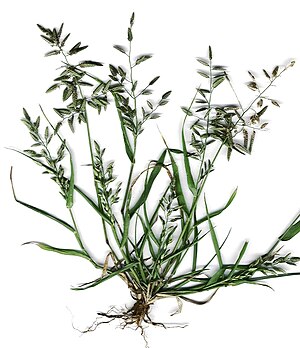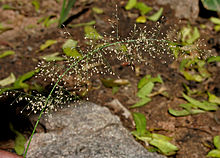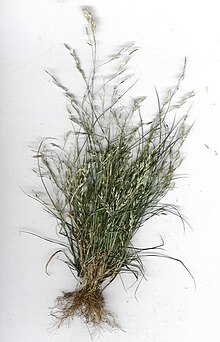Love grasses
| Love grasses | ||||||||||||
|---|---|---|---|---|---|---|---|---|---|---|---|---|

Great love grass ( Eragrostis cilianensis ) |
||||||||||||
| Systematics | ||||||||||||
|
||||||||||||
| Scientific name | ||||||||||||
| Eragrostis | ||||||||||||
| wolf |
The love grasses ( Eragrostis ) are a genus within the sweet grass family (Poaceae). This includes 413 species worldwide. The German trivial name is a direct translation of the scientific generic name (see below). Some representatives of the genus belong to a group of grains that are summarized under the term " millet ".
For Alsace , the common name is also used in the form of dear grass.
description
Vegetative characteristics
Love grasses are annual or perennial plants. They grow turf-shaped or occasionally in tufts. A few species such as Eragrostis hypnoides or Eragrostis barbinodis form runners . The species reach heights of growth between 10 and 300 centimeters. They are mostly herbaceous , only occasionally partially woody grasses. The one to twenty knotted stalks are mostly unbranched. The nodes are almost always hairless; rarely hairy such as Eragrostis annulata or Eragrostis kennedyae .
The mostly narrow, linear leaves and the inflorescences are often glandular. The leaf blades are mostly flat or, less often, rolled. The ligule is formed as a fine ring of hair, sometimes as a membranous membrane. Leaf auricles are rarely formed in the transition to the leaf sheath , the edges of which are not fused. The sheaths are keeled or rounded.
Generative characteristics
The inflorescences are open, contracted or spike-shaped ( Eragrostis chapelieri ) panicles . The laterally compressed, spherical to elongated spikelets are two- to many-flowered and hermaphroditic. They measure 1 to 40 millimeters in length and 0.5 to 8 millimeters in width. The glumes are often unevenly shaped and one to three-veined. The awnless, at most with a short tip, and one to five-veined lemmas are mostly glabrous, rarely hairy, keeled or rounded on the back. The male flowers have two, for example Eragrostis ciliaris , to in most cases three stamens . The female flowers have two stigmas .
The fruits are 0.4 to 2.4 millimeters long caryopses (grain), the pericarp is rarely free. The grains are free in all species and are scattered after a break has developed at the base of the lemmas holding them.
Metabolic pathway and sets of chromosomes
With the exception of Eragrostis walteri, all species are C4 plants .
The basic chromosome number is x = 10. Different degrees of ploidy with 2n = 20, 40, 50, 60, 80, 100 were determined.
distribution
Love grasses are widespread worldwide with a focus on the tropics and subtropics . They mainly colonize sandy or disturbed soils in open locations. Most of the species are considered to be weeds. Few representatives of the genus have economic importance as grain, such as the teff ( Eragrostis tef ) in Ethiopia or the hairy love grass ( Eragrostis pilosa ) in Central Africa and the Nile countries.


Systematics
The genus Eragrostis was established in 1776 by Nathanael Matthäus von Wolf in Genera Plantarum , p. 23. The generic name Eragrostis is an artificial word and is derived from the Greek word eros for love and the Middle Latin word agrostis for weeds, or Greek agrostis , the name of several different grasses. Synonyms for Eragrostis Wolf are: Boriskellera Terechov , Erochloe Raf. , Erosion Lunell , Exagrostis Steud. nom. inval., Macroblepharus Phil. , Psilantha (K.Koch) Tzvelev , Roshevitzia Tzvelev , Triphlebia Stapf , Vilfagrostis Döll nom. inval.
The genus love grasses ( Eragrostis Wolf ) belongs to the tribe Eragrostideae in the subfamily Chloridoideae within the sweet grass family (Poaceae).
The following species occur in Central Europe , some of which have been introduced:
- Elbe love grass ( Eragrostis albensis H.Scholz )
- Eragrostis barrelieri Daveau : It occurs from the Mediterranean area to Pakistan and from Macaronesia to the Arabian Peninsula.
- Large love grass ( Eragrostis cilianensis (All.) Janch. ): It occurs in Eurasia and Africa.
- Slightly curved love grass ( Eragrostis curvula (Schrad.) Nees ): It occurs from Cameroon to Eritrea and to southern Africa.
- Eragrostis frankii C.A.Mey. : It is native to the eastern United States to Texas .
- Eragrostis mexicana (Hornem.) Link (Syn .: Eragrostis neomexicana Vasey ex Beal ): It occurs from North America to Argentina.
- Lesser love grass ( Eragrostis minor host ): It is found in Eurasia and Africa.
- Japanese love grass ( Eragrostis multicaulis Steud. ): It occurs from tropical and subtropical Asia to Far Eastern East Asia.
- Eragrostis pectinacea (Michx.) Nees : It occurs in America.
- Hairy love grass ( Eragrostis pilosa (L.) P.Beauv. ): It occurs in Eurasia and Africa.
- Teff ( Eragrostis tef (Zucc.) Trotter ): It is native to northeastern and eastern tropical Africa and the Arabian Peninsula.
- Eragrostis virescens J. Presl : It occurs from western Canada to Mexico and from Venezuela to southern South America.
Other types (selection):
- Eragrostis amabilis (L.) Wight & Arn. : It occurs in the tropics and subtropics of the Old World.
- Eragrostis annulata Rendle ex Scott-Elliott : It occurs from Angola to southern Africa.
- Eragrostis balgooyi Veldkamp : The species first described in 2002 occurs only in New Guinea.
- Eragrostis barbinodis Hack. : It occurs from Mozambique to southern Africa.
- Eragrostis chapelieri (Kunth) Nees : It occurs in tropical and southern Africa and on Madagascar.
- Eragrostis ciliaris (L.) R.Br. : It occurs in the tropics and subtropics of the Old World.
- Eragrostis desertorum Domin : It occurs in Australia.
- Eragrostis dielsii Pilg. : It occurs in Australia.
- Eragrostis dyskritos Lasut : The species first described in 2009 occurs on Sulawesi .
- Eragrostis elongata (Willd.) J.Jacq. : It occurs from tropical and subtropical Asia to Australia.
- Eragrostis episcopulus Lambdon, Darlow, Clubbe & Cope : The species first described in 2012 occurs on St. Helena .
- Eragrostis ferruginea (Thunb.) P.Beauv. : It occurs from the Himalayas to temperate East Asia.
- Eragrostis grandis Hildebr. : It occurs in Hawaii .
- Eragrostis hypnoides (Lam.) Britton, Stern & Poggenb. : It occurs in America.
- Eragrostis japonica (Thunb.) Trin. : It occurs in the tropics and subtropics of the Old World.
- Eragrostis kennedyae F. Turner : It occurs in Australia.
- Eragrostis lepida (A.Rich.) Hochst. ex Steud. : It occurs from northeastern tropical Africa to Kenya and on the Arabian Peninsula.
- Eragrostis maderaspatana Bor : It occurs in India and Sri Lanka.
- Eragrostis paniciformis ( A. Braun ) Steud. : It occurs from Eritrea to Zambia.
- Eragrostis peruviana (Jacq.) Trin. : It occurs from Peru to Chile and on the Desventuradas Islands .
- Eragrostis sabulosa (Steud.) Schweick. : It occurs in South Africa.
- Eragrostis tremula Hochst. ex Steud. : It occurs in tropical Africa and from Afghanistan to Indochina.
- Eragrostis variabilis (Gaudich.) Steud. : It occurs in Hawaii .
- Eragrostis xerophila Domin : It occurs in Australia.
Sources and further information
- Description of the genus Eragrostis in L. Watson & MJ Dallwitz: The Grass Genera Of The World .
- Description of the genus Eragrostis in the Flora of Taiwan .
- Description of the genus Eragrostis in the Flora of China .
Individual evidence
- ^ Georg August Pritzel , Carl Jessen : The German folk names of plants. New contribution to the German linguistic treasure. Philipp Cohen, Hannover 1882, page 142. ( online ).
- ↑ E. Bayer: Important and interesting useful plants from the grass family. In: Bavarian Academy of Sciences (editor): Grasses and grasslands: Biology - Use - Development , round table on October 10, 2005, Verlag Dr. Friedrich Pfeil, Munich ISSN 0938-5851 , ISBN 3-89937-070-8
- ↑ Entry in Tropicos. last accessed on March 2, 2003
- ↑ To be precise: Etymological dictionary of botanical plant names. Pp. 46, 232
- ↑ Eragrostis. In: Germplasm Resources Information Network (GRIN). United States Department of Agriculture, accessed March 1, 2013 .
- ↑ Jürg Röthlisberger: The genus Eragrostis in Switzerland - a location determination . Bauhinia 19, 2005 PDF
- ↑ Henning Haeupler , Thomas Muer: picture atlas of the fern and flowering plants of Germany (= The fern and flowering plants of Germany. Volume 2). Published by the Federal Agency for Nature Conservation. Ulmer, Stuttgart 2000, ISBN 3-8001-3364-4 .
- ↑ a b c d e f g h i j k l m n o p q r s t u v w x y z aa ab ac ad ae af ag ah ai aj Rafaël Govaerts (Ed.): Eragrostis. In: World Checklist of Selected Plant Families (WCSP) - The Board of Trustees of the Royal Botanic Gardens, Kew . Accessed January 31, 2020.
- ↑ Helmut Herwanger: Exciting story about a new floristic find for Baden-Württemberg . In: Oberschwaben naturhah . Journal of the Federation for Nature Conservation in Oberschwaben e. V. and the nature conservation center Bad Wurzach, annual issue 2012, p. 36 f.
- ↑ Species list at Germplasm Resources Information Network (GRIN).



